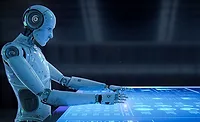How AI can be used to improve healthcare security operations
Hospitals, elder-care facilities and other segments of the healthcare industry have been forced to be reactive during the past year, as they found themselves overwhelmed with cases, injured by the loss of routine and in the position of mitigating pandemic health risks for both patients and staff – as well as provide routine and elective care to the most vulnerable. Decision-makers for healthcare facilities have been tasked with finding solutions to manage patient occupancy levels, ensure compliance in usage of Personal Protection Equipment (PPE), and promote social distancing in administrative and other non-patient care areas of their facility.
While Artificial Intelligence (AI) has already been introduced into medical facilities – revolutionizing the research and development methods of critical disease treatments, it’s also bringing about a transformation in healthcare security operations. With technologies such as smart cameras and IoT platforms to better manage field level operations, healthcare organizations are seeing the possibility of a more streamlined, efficient and cost-effective way to manage their facilities.
Smart surveillance solutions, which employ AI-infused video analytics in the form of apps, are increasingly being used in acute, post-acute and long-term care settings as an efficient way to implement pandemic measures. Beyond that, this technology can also provide long-term flexibility, as the cameras can simultaneously run multiple apps, performing multiple functions. Here are a few ways smart cameras can be used to optimize healthcare facilities:
Enhanced patient privacy through privacy mask applications
Many countries have strict legal requirements for video surveillance to protect the privacy and security of patient health information. AI-enabled smart cameras can help improve patient privacy. As sensitive health data is often displayed on computer screens, smart video analytics can employ privacy mask applications that can hide a configurable set of objects, such as laptops, keyboards and people in video. This also allows for enhanced monitoring of elderly and dementia patients in their rooms, without violating their privacy.
Real-time detection of fallen patients or residents
Every healthcare facility is required to reduce the risk of patient harm from falls. Smart surveillance cameras can reduce these occurrences by detecting spills when they occur, enabling staff to take immediate action and preventing a potential fall. Fall detection enables IoT cameras to monitor and analyze the behavior of patients, visitors and staff in real-time, while using AI video analytics to automatically detect whether a person stands upright, lies on the floor or remains seated. Using these analytics, the camera will alert staff in the case of unusual behavior – making every walk from bed to toilet much safer, especially for elderly and disabled patients.
Optimize patient transportation and parking management
With connections into patient admission and registration systems, smart cameras can register patient transport access by automatically logging arrival times, license plate numbers and parties involved. This helps staff to increase operations speed and quality. For large hospitals with multiple parking garages, smart surveillance can prevent parking violations by providing real-time parking protection for gateless parking lots or detecting unauthorized parking, minor accidents or potential break-ins in real-time and alert security as needed. The same devices can also be used to detect the obstruction of driveways that may cost approaching ambulances critical seconds.
Increase general safety, security and improve building performance
The general hospital environment is burdened with complex inherent risks, not the least of which is the prevention and early detection of smoke and fire, which can cause devastating damage in healthcare facilities where many people are gathered in confined spaces or are bed-ridden. Security cameras equipped with AI video analytics can provide 24/7 surveillance, allowing security managers to detect hazards early without having to constantly monitor video streams. Applications enable cameras to analyze video data and distinguish dangerous from harmless situations, for example, menacing smoke from cigarette smoke, or sunlight from fire, reducing false alarms. Additionally, applications can monitor virtual lines inside buildings to notify appropriate personnel if an individual accesses a restricted supply closet stocked with medical equipment, materials and drugs. The app allows human operators to define an unlimited number of areas and virtual lines within a scene, so the functionality can be fully adapted to individual needs and onsite conditions.
The future of smart surveillance in healthcare
The great benefit of IoT lies in its ability to connect devices and process data in a smart way. This enables security cameras equipped with AI to analyze video data in real-time and automatically trigger appropriate actions to relieve humans from recurring jobs – unlocking great potential for process automation to make operations more efficient. As requirements for safety and security in healthcare become increasingly complex, due to stricter legal and pandemic regulations, AI-enabled smart cameras can help healthcare organizations increase patient and employee confidence, reduce risk-related costs and help to optimize operational processes.
This article originally ran in Security, a twice-monthly security-focused eNewsletter for security end users, brought to you by Security Magazine. Subscribe here.
Looking for a reprint of this article?
From high-res PDFs to custom plaques, order your copy today!








